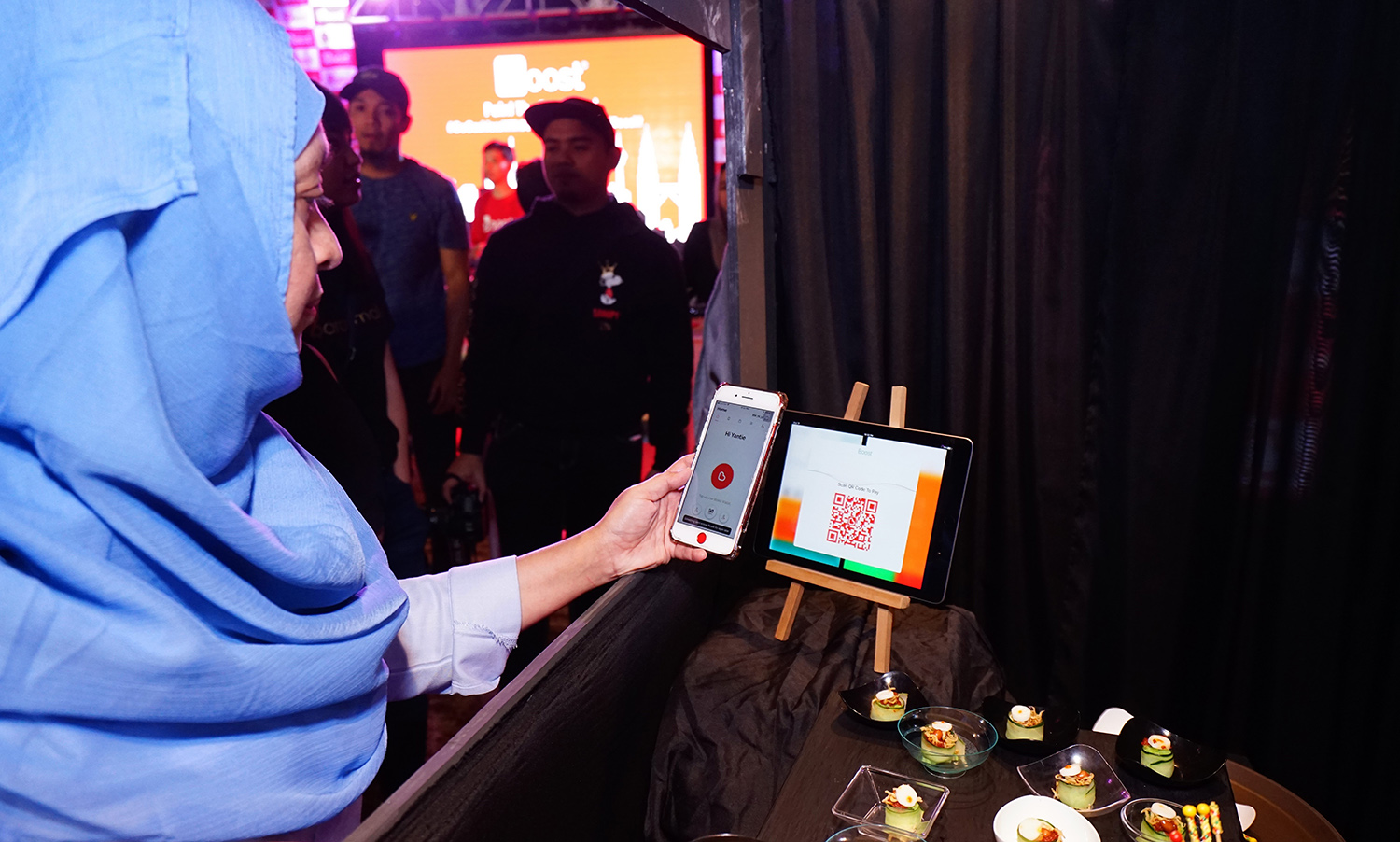A year on, Axiata Digital tags on mobile wallet to Boost app
By Edwin Yapp January 30, 2018
- Boost can create reasons to change consumer behaviour, drive adoption: CEO
- Still a ways to go as cash is still king; cultural, technological resistance likely to be felt
BOOST, the digital mobile wallet (e-wallet) app developed by Axiata Digital Services Sdn Bhd, has set a lofty target of being a leading player in Malaysia by aiming to acquire as many as 100,000 merchants by the end of 2018.
But as sanguine as company officials were about the prospects of growth, industry watchers warn that adoption amongst consumers may be more challenging than the industry expects it to be.
Speaking to the media during a Chinese New Year promotional event called ‘Paint The Town Red with Boost!’ on Jan 29, Boost chief executive officer (CEO) Christopher Tiffin (pic, below), claimed that currently, the company has acquired about 5,500 merchants and has over 800,000 users on the Boost app since the company launched its eponymous mobile wallet service one year ago.
“We aim to be Malaysia’s preferred homegrown digital wallet,” he confidently declared during the event.
“As of January, we have some 810,000 users [of the app] and counting. We’ve done well since launching our mobile wallet last October and we aim to acquire 100,000 merchants by year-end.”
Boost began life as a lifestyle loyalty and prepaid top-up app on Jan 6, 2017, Tiffin said. Over the course of the year, the app now supports gamification and social interaction features.
Users are able to collect loyalty rewards, send and receive e-vouchers, transfer and receive money, all via its Boost app. Finally, in October last year, Boost added a mobile wallet functionality, which empowers users to make payments in a convenient way, Tiffin explained.
“We focused first on getting the customer experience right as that is the basis for the other services [on the app],” he said, adding that he believes that the gamification and social interaction features contributed to how the app gained a large user base.
Tiffin said there are three categories of merchants, which accept the Boost mobile wallet app. The first are mainly cash-based merchants comprising hawkers, food trucks, simple stalls at night markets and eateries in malls and even on the roadside.
Users who patronise these merchants can scan the static QR code displayed at these stalls, enter the amount to be paid, and authorise the payment via a PIN code on the app. Upon doing so, the merchant will, in a few seconds, receive a transaction confirmation that payment has been received.
The second category involves more established merchants such as cafes, restaurants and other retailers, in which their payment systems are tied to point-of-sales (POS) terminals. In these cases, a dynamic QR will be displayed on their POS system screen, whereupon users can scan the QR code, authorise the payment with their PIN code, and payment will be reconciled with the merchant’s POS system.
Finally, the third category is similar to the second, except that they are classified as online merchants, the likes of Lazada, Shopee, Zalora, and 11Street.
Tiffin revealed that as much as 50% of the 5,500 merchants currently are in the first category, and mainly deal in cash; 20% to 30% comprise those in the second category, while the rest comprise online merchants.
Adoption not great
Whilst there is understandably a lot of excitement surrounding the use of mobile wallets in the region due to its convenience and novelty, including in Malaysia, the adoption of such a nascent payment mechanism has not been as encouraging as the industry would have you believe.
Even in neighbouring Singapore, which is widely acknowledged as a model example of an advanced society with high mobile penetration rates and high-income status, mobile wallets haven’t taken off in a big way yet.
In a National Day Rally speech last year, Singapore’s Prime Minister Lee Hsien Loong noted that while Singapore had all the makings of a digitally literate and connected country, Singapore still lags behind countries such as China in the use of e-payments and/or mobile wallets.
Lee had argued that the industry is fragmented with too many “different schemes and systems that do not talk to one another,” which in turn discourages usage.
A recent investigation by The Straits Times noted that cash is still king in a nation that claims to be a smart nation, and that generally six in 10 consumer transactions are made in cash in the island-state. This figure goes up to 70% in residential areas, where state-owned HDB flats dominate, the daily added.
Things in Malaysia aren’t any better. According Bank Negara Malaysia’s Financial Stability and Payments Systems Report 2016, Malaysians made only 3.4 transactions per capita using debit cards last year, up 17.2% from 2.9 per capita in 2015.
To make matters more complicated the central bank has issued some 31 e-money licences – five to banks and 26 to non-bank entities – to companies that could enable them to launch mobile wallet products.
So many players in a nation of merely 30 million people could potentially fragment the market further and possibly confuse consumers as to which system is the best to use, industry watchers have argued.
“There are too many players in this space, and consolidation is likely to happen in the near future, even before mobile wallets have taken off in a big way,” said one payment industry insider Digital News Asia (DNA) spoke to. “This isn’t a good thing.”
Still, Boost officials at the launch remained optimistic that it can grow the mobile wallet market share in time to come.
Quizzed as to how it plans to drive adoption given that mobile wallets, loyalty programmes, gamification and social interactions normally appeal only to younger users below 35, Boost officials were bullish that it had the right formula for driving adoption.
“We’re trying to create a critical mass amongst the youth first, and use that to drive all other segments,” argued Mohd Khairil Abdullah (pic, above), CEO of Axiata Digital Services, the parent company of Boost.
Tiffin added, “We need to find the right ecosystem to drive adoption and we believe youth is a key driver of the ecosystem. For example, using the app means children can get their parents to send money to them and vice versa.
“This is very important as through this, we will be able to get people of different age groups and different segments within the market to use the app,” he argued. “It’s about creating reasons to change consumer behaviour, and that is done through interaction with friends or family.”
Tiffin also revealed that for the first year, Boost will not be charging merchants for the usage of its mobile wallet system, arguing that this is one way to further drive adoption.
“Traditionally, merchants have to pay fees but with Boost, we are saying it’s free [for the first year],” he declared.
“Thereafter, if we levy charges, it will be significantly lower than what traditional players charge,” he claimed.
Boost has also recently signed with two Malaysian universities – UTM and UiTM – in a bid to get students to use its services and spur adoption in their respective campuses.
Cash versus change
Industry observers have noted that displacing cash isn’t a matter of merely replacing a payment mechanism with technology and loyalty incentives, even when such systems are supposedly driven by the use of a ubiquitous device such as the smartphone.
Anecdotal evidence suggests that some consumers just aren’t comfortable with signing up with a provider like Boost because they have to surrender personal information in lieu of using the mobile wallet service.
Then there is the merchant side of the equation. What impetus is there for hawkers and casual eateries to jump onto the bandwagon? Is the bother of dealing with such electronic-based systems worth the trouble when cash is still the most convenient legal tender as of today?
These struggles are real, as exemplified by a recent investigation by Singapore’s Channel News Asia, which laid bare the struggles of getting hawkers on board mobile wallets.
And there is also the issue of the unbanked, citizens, senior or otherwise, who are not technology savvy, and why and how they would get on board such systems.
 According to Forrester Research analyst Zhi Ying Ng (pic, right), there are three impediments that need to be overcome in the adoption of mobile payment systems. Speaking to DNA in an email, Ng said the first is demonstrating that there is a clear improvement over existing systems.
According to Forrester Research analyst Zhi Ying Ng (pic, right), there are three impediments that need to be overcome in the adoption of mobile payment systems. Speaking to DNA in an email, Ng said the first is demonstrating that there is a clear improvement over existing systems.
She argued that developing a new payment system that is demonstrably better than existing alternatives like cash and plastic cards is a difficult task.
“To trigger adoption by consumers and merchants, new payment systems must offer obvious and compelling advantages over the alternatives, such as greater simplicity, higher speed, greater security against fraud, more control, lower costs, or better reliability,” she argued.
Ng said the next hurdle has to do with overcoming the ‘chicken-and-egg’ problem that consumers typically won’t adopt a payment system until it’s widely accepted by merchants and vice versa.
Payment systems, she argued, are subject to strong network effects – the more consumers or merchants use a system, the more attractive it becomes for others to join.
Lastly, new payment systems often require substantial infrastructure investments that are unlikely to pay off until years into the future, she pointed out.
“Because consumers generally won't pay to use a new system, merchants, banks, and payment system operators often squabble over who should pick up the bill,” she explained.
“Unrealistic expectations of the revenues available from mobile payments, for example, are at least partly to blame for the failure of mobile payments to grow.”
Said the payment industry insider DNA spoke to, “As with everything in life, people need to get into the habit of using mobile wallets but there isn’t a way to instil this habit against giving up cash.
“The trick now is to tackle the question of ‘How do you instil this habit?’ Cash is what people are used to, and the older generation is likely to be resistant to picking up the habit. Is there a forceful way to create habit? Does this lie in having more users of mobile wallets? Or does it require more merchants to push this? These are questions that the industry must address.”
Related stories:
Boost partners UTM to create country’s first Cashless Campus
Maybank partners Alipay to provide contactless payments convenience
Interoperable QR payments in Singapore for consumers and merchants
For more technology news and the latest updates, follow us on Facebook, Twitter or LinkedIn





